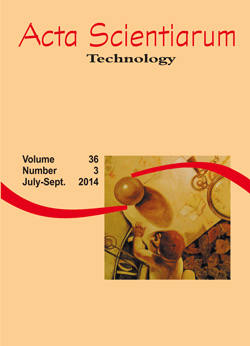<b>The use of sodium alginate-based coating and cellulose acetate in papaya post-harvest preservation
DOI:
https://doi.org/10.4025/actascitechnol.v36i3.17645Palavras-chave:
coating, ripening, storageResumo
This study aimed to evaluate the ripening of papaya fruit (Carica papaya L.) at room temperature (±25°C) and10°C with 80% relative humidity, coated with edible film based on sodium alginate (1%) and cellulose acetate film (3%) by dipping the fruit in the suspensions for 1 min. On the application of the treatment and every three days during 12 days of storage, fruit were evaluated for weight loss, firmness, total carotenoid content, lycopene content and vitamin C content of the pulp. The cellulose acetate film extended the shelf-life of papayas, without affecting their quality. This treatment delayed fruit ripening, whose changes in all the parameters analyzed were significantly slower than fruit treated with sodium alginate-based coating. The coating with cellulose acetate at 3% was more effective in the preservation of papaya stored for 12 days under both temperatures.
Downloads
Downloads
Publicado
Como Citar
Edição
Seção
Licença
DECLARAÇíO DE ORIGINALIDADE E DIREITOS AUTORAIS
Declaro que o presente artigo é original, não tendo sido submetido í publicação em qualquer outro periódico nacional ou internacional, quer seja em parte ou em sua totalidade.
Os direitos autorais pertencem exclusivamente aos autores. Os direitos de licenciamento utilizados pelo periódico é a licença Creative Commons Attribution 4.0 (CC BY 4.0): são permitidos o compartilhamento (cópia e distribuição do material em qualqer meio ou formato) e adaptação (remix, transformação e criação de material a partir do conteúdo assim licenciado para quaisquer fins, inclusive comerciais.
Recomenda-se a leitura desse link para maiores informações sobre o tema: fornecimento de créditos e referências de forma correta, entre outros detalhes cruciais para uso adequado do material licenciado.























